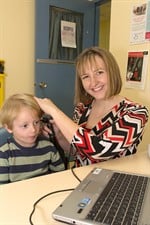The Kids's Dr Ruth Thornton is one of 12 finalists in the annual national Fresh Science competition with her research into middle-ear infections. Her findings could reduce the need for antibiotics and surgery, and help tackle hearing loss in Indigenous communities.
Dr Thorton is part of an University of Western Australia team that have discovered the sticky nets of DNA hide bacteria in the ears of kids with recurrent middle-ear infections, and evade antibiotic treatment by creating impenetrable slimy biofilms.
The researchers are targeting these nets with a drug that has already proven its ability to help kids with cystic fibrosis by breaking up thick secretions in their lungs. A study on the DNA net discovery was published in the online science journal Plos One in February and clinical drug trials are now underway.
"Bacteria in the ear hide in a sticky glue made up of big nets of DNA from the children's own immune system," Dr Thornton said. "It is similar to what happens in the lungs of people with cystic fibrosis, where a treatment known as Dornase alfa is used to break up this sticky DNA."
"We are now trialling this treatment in the ears of children when they have grommets inserted. We believe this could get rid of these bacteria and stop children getting more infections and needing more ear surgery."
Middle ear infection, or otitis media, is one of the commonest childhood complaints. It occurs in the space behind the eardrum where fluid collects and bacteria can cause painful infections. For some children, this fluid doesn't go away and becomes like egg white over time, leading to "glue ear".
However, some children strike it doubly unlucky with chronic infections that resist antibiotics and require the insertion of ventilation tubes, or grommets, in their eardrums. Thirty per cent of these children need repeat grommet surgery due to re-infection, and the condition's chronic nature has been associated with hearing loss and learning difficulties.
The clinical trials at UWA involve 60 children under the age of five, who will each receive Dornase alfa in one ear during grommet surgery. The other ear will be used as a comparison and receive only surgery. Results will be collected over two years, with a larger national trial planned later.
There are also plans to trial the treatment in indigenous children who suffer from high rates of severe chronic middle ear infections, and which can cause extensive hearing loss and chronically weeping ears.
"This is the first potential change in treating middle-ear infections for a long time, and more effective treatments will hopefully lead to improved hearing, better learning outcomes and a reduced burden on children and their families," Dr Thornton said.
MEDIA REFERENCE
Research Assistant Professor Ruth Thornton (+61 8) 9340 8340 / (+61 4) 00 344 451 UWA School of Paediatrics and Child Health; Honorary Research Fellow: The Kids for Child Health Research; Princess Margaret Hospital for Children
Michael Sinclair-Jones (+61 8) 6488 3229 / (+61 4) 00 700 783 UWA Public Affairs

